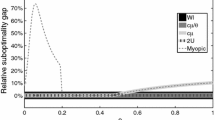Abstract
This paper studies theadmission andscheduling control problem in anM/M/2 queueing system with nonidentical processors. Admission control renders when a newly arrived job should be accepted, whereas scheduling control determines when an available processor should be utilized. The system received a rewardR when a job completes its service and pays a unit holding costC while a job is in the system. The main goal of the paper is to obtain the admission/scheduling policy that maximizes the expected discounted and long-run average profits (reward minus cost). We convert the system into its dual, a stochastically identical system subject toexpulsion/scheduling control, and prove that the individually optimal policy in the dual system is socially optimal in the original system. In contrast with the dynamic programming (DP) technique which considers the system as a whole, we adopt the viewpoint of an individual job and analyze the impact of its behavior on the social outcome. The key properties which simplify the analysis are that under the individually optimal policy the profit of a job under the preemptive last-come first-priority service discipline (LCFP-P) is independent of jobs arrived earlier than itself and that the system is insensitive to service discipline imposed. The former makes possible to bypass complex dynamic programming analyses and the latter serves as a vehicle in connecting the social and individual optimality. We also exploit system operational characteristics under LCFP-P to obtain simple and close approximations of the optimal thresholds.
Similar content being viewed by others
References
M. Bartroli and S. Stidham, Admission to a general stochastic congestion system: Comparison of individually and socially optimal policies, Technical Report, Department of Operations Research, University of North Carolina, Chapel Hill, NC 27599 (1990).
C.E. Bell and S. Stidham, Individual versus social optimization in the allocation of jobs to alternative processors, Manag. Sci. 29 (1983) 831–839.
D. Bertsekas,Dynamic Programming (Prentice-Hall, Englewood Cliffs, NJ, 1987).
J.A. Buzacott and J.G. Shanthikumar,Stochastic Models of Manufacturing Systems (Prentice-Hall, Englewood Cliffs, NJ, 1992).
R.B. Cooper, Queues with ordered processors that work at different rates, Opsearch 13 (1976) 69–78.
R. Hassin, On the optimality of first come last served queues, Econometrica 53 (1985) 201–202.
W. Lin and P.R. Kumar, Optimal control of a queueing system with two heterogeneous servers, IEEE Trans. Auto. Contr. AC-29 (1984) 211–216.
S.A. Lippman, Applying a new device in the optimization of exponential queueing systems, Oper. Res. 23 (1975) 687–710.
R. Nelson and D. Towslew, Approximating the mean time in system in a multiple-processor queue that uses threshold scheduling, Oper. Res. 35 (1987) 419–427.
E. Parzen,Stochastic Processes (Holden-Day, 1962).
S. Ross,Introduction to Stochastic Dynamic Programming (Academic Press, New York, 1983).
A. Rubinovitch, The slow processor problem: A queue with stalling, J. Appl. Prob. 22 (1985) 879–892.
J.G. Shanthikumar and D.D. Yao, Comparing ordered-entry queues with heterogeneous processors, Queueing Syst. 2 (1987) 235–244.
S. Stidham, Jr., Optimal control of admission, routing, and service in queues and networks of queues: A tutorial review,Proc. ARO Workshop: Analytical and Computational Issues in Logistics R&D, George Washington University (1984) pp. 330–377.
S. Stidham, Jr., Scheduling, routing, and flow control of stochastic network, in:Stochastic Differential Systems, Stochastic Control Theory and Applications, IMA Vol. 10, eds. W. Fleming and P.L. Lions (Springer, New York, 1988) pp. 529–554.
J. Walrand, A note on “Optimal control of a queueing system with two heterogeneous processor”, Syst. Contr. Lett. 4 (1984) 131–134.
J. Walrand,Introduction to Queueing Networks (Prentice-Hall, Englewood Cliffs, NJ, 1989).
R.W. Wolff,Stochastic Modeling and the Theory of Queues (Prentice-Hall, Englewood Cliffs, NJ, 1989).
S.H. Xu and J.G. Shanthikumar, Optimal expulsion control — A dual approach to admission control of an ordered-entry system, Oper. Res. 41 (1993) 1137–1152.
D.D. Yao, The arrangement of processors in an ordered-entry system, Oper. Res. 35 (1987) 759–763.
D.D. Yao and J.G. Shanthikumar, Exact analysis of ordered-entry systems, Management Science Working Paper No. MS-26, University of California, Berkeley, CA 94720 (1985).
Author information
Authors and Affiliations
Rights and permissions
About this article
Cite this article
Xu, S.H. A duality approach to admission and scheduling controls of queues. Queueing Syst 18, 273–300 (1994). https://doi.org/10.1007/BF01158765
Received:
Revised:
Issue Date:
DOI: https://doi.org/10.1007/BF01158765




